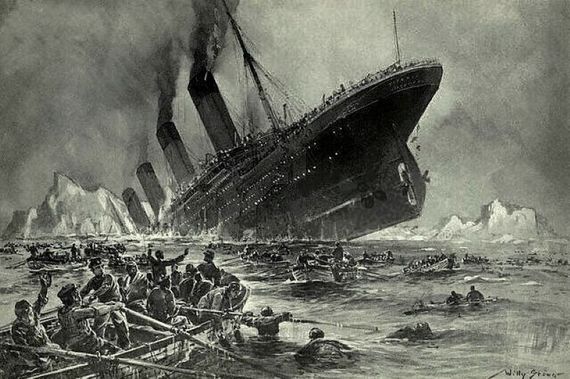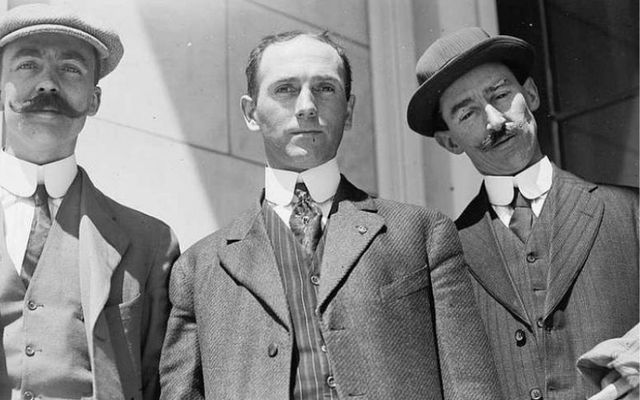Irish man William Burke survived the Titanic after heroically saving a woman from drowning or freezing to death in the perishing waters.
Editor's note: On April 15, 1912, the Belfast-built RMS Titanic sank after colliding with an iceberg, killing over 1,500 passengers and crew on board. This was one of the deadliest commercial peacetime maritime disasters in modern history and among those on board were many Irish.
IrishCentral takes a look at the Irish on board – the lucky, unlucky and heroic.
This is an extract from the book “The Irish Aboard the Titanic” by Senan Molony which tells the tales of the people who were on board the night the ship went down. This book gives those people a voice. In it are stories of agony, luck, self-sacrifice, dramatic escapes, and heroes left behind.
William Burke
Dining-room steward.
From: Queenstown, County Cork.
Residence: 57 Bridge Street, Southampton.
William Burke (30) saved a woman from drowning when she jumped from the Titanic but missed the lifeboat. He caught her by the ankle and held fast in one of the most terrifying individual incidents of the whole drama. The woman was then taken back aboard the ship at the deck below.
A dining-room steward in First Class, Burke was assigned to Isidor and Ida Blun Strauss, the elderly owner of Macy’s Department Store in New York and his wife, who chose to die together when the supreme test came.

An illustration of the Titanic sinking.
In his testimony to the American inquiry, Burke told Senator William Alden Smith how he was in his bunk, awake, in a dormitory of dining room stewards, when the ship struck:
"When I first felt the impact I did not know exactly what to make of it. I thought probably she had dropped her propeller or something. I did not get up right away. I waited for probably a quarter of an hour. About a quarter of an hour or 20 minutes later the order came to get out lifebelts and get up on deck and take our overcoats.
"Mention was made of the fact that it was very cold. I immediately got up with everybody else. Everybody was taking a lifebelt. I did not at that time bother about a lifebelt. I put on my coat and dressed in the ordinary way. As we were going out one of the last men said, “There is a lifebelt near my bunk if you want one.” I went back and got this lifebelt, and carried it out and took it up on deck. I went to the boat deck on the starboard side.

Victims of the Titanic sinking in lifeboats.
"I went to my station from there and found my boat (No. 1) had gone. I thought the next best thing to do was to assist with some other boat … As I got to No. 10 boat, the Chief Officer was there [Henry Wilde].
"I just heard him say, 'How many seamen are in that boat?' The answer came back, 'Two, sir.' He turned to some man standing there and said, 'Is there any man here can pull an oar?' Nobody answered, but a man who seemed to me like a foreigner got close to him, and I didn’t hear what he said, but he simply pushed him aside, and said, 'You are of no use to me.' I went to him and told him I could pull an oar but was not anxious to go unless he wanted me to go. He said, 'Get right in there', and he pushed me toward the boat, and I simply stepped in the boat and got in …
"When there were no more women to be had around the deck the Chief Officer gave the order for the boat to be lowered. I might say that about the last woman that was about to be passed in slipped and was about to fall between the ship and the boat when I caught her. I just saved her from falling. Her head passed toward the next deck below. A passenger caught her by the shoulders and forced me to leave go. It was my intention to pull her back in the boat. He would not let go of the woman but pulled her right on the ship.
"Senator Smith: ‘Do you know who the woman was?’
"– 'No sir; I did not know her.'
"Senator Fletcher: ‘Do you know whether she succeeded in getting into another boat or not?’
"– ‘I couldn’t say. I supposed she got into another boat.’"
(US Inquiry, pp. 821–826).

Love Irish history? Share your favorite stories with other history buffs in the IrishCentral History Facebook group.
Able seaman Frank Evans said that the woman wore a black dress, and suggested that perhaps her heel had caught in the Titanic’s rail as she jumped. He testified that after her rescue she came back up to the boat deck, jumped, and this time landed safely in lifeboat No. 10.
Burke later returned to England on the Red Star Line’s SS Lapland. He stayed working on the sea and in related trades and retired to Liverpool, originally White Star’s home port.
"The late William Burke, from Albert Edward Road in Wavertree, was a ship steward. He was woken by a fellow crewmember, who came up to his bunk bed brandishing a piece of ice which had sheered off the iceberg as it hit the ship.
"In an interview with the Echo, he recalled: ‘I was sent to lifeboat station number ten and when a woman passenger leapt to board it, she slipped and was about to fall into the sea when I grabbed her.
"‘I hung on to her, but it was a terrific strain. Then, just as I thought I must let go, we reached the level of the next deck and two sailors clasped her by the head and shoulders and hauled her to safety.
"‘Our boat was so full that everyone had to stand. At first, we could not believe the
Titanic would sink … but sink she did, and the hours from when I was roused from my bunk to the time we got picked up by the Carpathia are not ones which I am anxious to recall.’"
(Liverpool Echo, 1956)
“The Irish Aboard the Titanic” by Senan Molony is available online.
* Originally published in 2012, updated in April 2024.




Comments